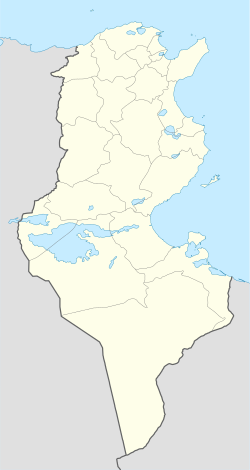Korba, Tunisia
From Wikipedia, the free encyclopedia
| Korba | |
|---|---|
| | |
| Coordinates: Coordinates: 36°34′N 10°52′E / 36.567°N 10.867°E | |
| Country | |
| Governorate | Nabeul Governorate |
| Population (2004) | |
| - Total | 34,807 |
| Time zone | CET (UTC1) |
| |
History
Ancient geographers and itineraries mention the town Curubis on the African coast between Clupea (modern Kelibia) and Neapolis (modern Nabeul).[2]The earliest historical record is an inscription from the time of the Roman civil war, which records that the Pompeian generals P. Attius Varus and C. Considius Longus fortified the town in 46 B.C.[3] In the years after the civil war the town was made a Roman colony, colonia Iulia Curubis (Pliny the Elder refers to it as libera, "free"), perhaps as part of Julius Caesar's attempt to rid his army of older soldiers and at the same time hold Africa against Pompeian forces.[4] In the year A.D. 257, the Carthaginian bishop Cyprian was exiled there; his biographer Pontius, who accompanied him into exile, praises the place (12): "provisum esse divinitus … apricum et conpetentem locum, hospitium pro voluntate secretum et quidquid apponi eis ante promissum est, qui regnum et iustitiam dei quaerunt." ("by god's favour a sunny and appropriate place was provided, a refuge secluded as he wished, and whatever was previously promised to be set before those who seek the kingdom and justice of god").
By the year 411, Curubis, like many African towns, had its own bishop (mentioned in the proceedings of the Council of Carthage of that year).[5] A bishop of Curubis is mentioned again in the Notitia provinciarum et civitatium Africae in the year 484, among the bishops exiled to Corsica for refusing to swear allegiance to the Vandal king Hilderic,[6] and again in the proceedings of the Council of Carthage of the year 525.[7]
The town had its own theatre. An inscription of the late second century honours the citizen who had created it.[8] Remains of an aqueduct survived to modern times; and the contribution to a mosaic in Ostia by shipowners of Curubis suggest that the town also possessed a port, which has not survived.[9]
Literature
- Broughton, T.R.S. (1929) The Romanization of Africa Proconsularis (Baltimore and Oxford: The John Hopkins Press and OUP)
- Dessau, H. (1901) "Curubis" R.E. IV 1893
- Mommsen, T., (1895) "Inschriften von Curubis und Lilybaeon", Hermes 30, 456-62 (online at Gallica)
- Trousset, P. (1994) "Curubis (Korba)" Encyclopédie Berbère, 2157 (Aix-en-Provence: Édisud) ISBN 2-85744-201-7
Footnotes
- ^ Recensement de 2004 (Institut national de la statistique) Census
- ^ Plin. nat. 5, 24 libera (sc.oppida) Curubis, Neapolis "free cities, Curubis, Neapolis"; Ptol. 4, 3, 2; Itin. Anton. Aug. p. 56, 7. al. See Dessau (1901); TLL Onom. II 771, 11 sqq.
- ^ CIL VIII 24099; Mommsen (1895), 456-60 with discussion of the inscription; Dessau (1901).
- ^ Broughton (1929), 54-5; CIL VIII 980 and 12452. The town was apparently already a colony by the year 45 B.C., when an inscription, CIL VIII 12451, shows a duovir again repairing the walls, or possibly, as Mommsen (1893), 460, suggests, completing the construction begun by the Pompeian generals. For discussion of the puzzles of this inscription, see CIL I2 p. 951, with further literature.
- ^ Conc. Carth. a. 411, 1, 198.
- ^ Not. episc. proc. Afr. 36. See the edition of S. Lancel (Paris: Les Belles Lettres, 2002) Victor de Vita, 184 and 339.
- ^ Conc. Carth. a. 525 p. 271.
- ^ Inscriptiones Latinae Selectae (ed. Dessau) n. 9407.
- ^ Trousset (1994); CIL XIV 4549, 34 naviculari Curbitani (late second century).




Aucun commentaire:
Enregistrer un commentaire